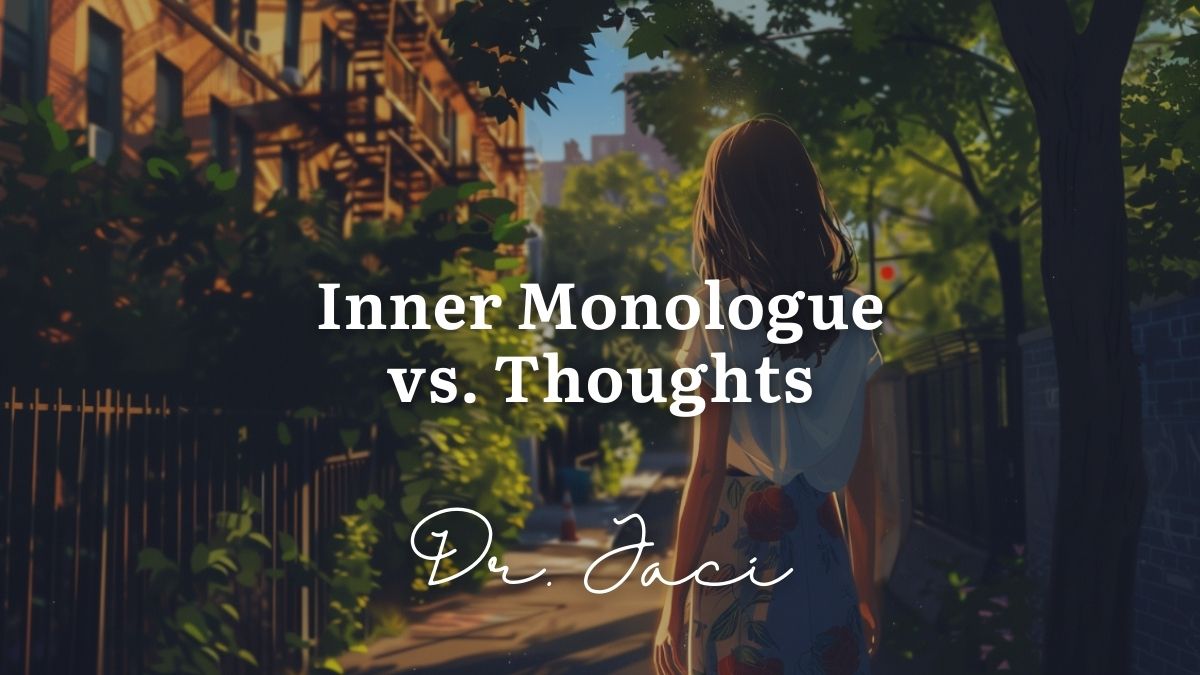As a clinical psychologist, clients often ask about the difference between our inner monologue vs. thoughts.
There seems to be a lot of confusion around distinguishing between these two related, but distinct mental activities.
In this post, I’ll define what each is, provide illustrative examples, and highlight how they differ.
What is an Inner Monologue?
An inner monologue refers to the semi-constant internal narrative that runs through our minds.
It’s that voice inside your head that seems to verbalize your thoughts, speak to you, and comment on your experiences throughout the day.
For example, your inner monologue may say things like:
- “I need to remember to call Mom later.”
- “This cafe makes the best lattes.”
- “I wonder if it’s going to rain today?”
It’s an active stream of conscious thought made up of words, sentences, and a conversational style. It often feels like you’re talking to yourself inside your head.
Many of my clients report having an active, chatty inner monologue that pipes up frequently throughout their waking hours.
Others say theirs is more intermittent, only vocalizing deliberately directed thoughts and observations.
What are Thoughts?

Thoughts refer to the broad range of ideas, impressions, mental images, memories, and associations that pass through our minds each day.
Thoughts include:
- Visual imagery and sensory impressions
- Abstract concepts and ideas
- Random associations, fantasizing about someone, and daydreams
- Memories and recollections
- Problem-solving ruminations
- Emotions and feelings
While some thoughts may take shape as verbalized words in your inner monologue, many occur as non-verbalized impressions flowing through your mind.
For example, you might visually picture your childhood home or a beach you once visited without verbalizing descriptions in your mind.
Or you may find yourself lost in abstract thought as you contemplate the passage of time.
Inner Monologue vs Thoughts Difference
The key difference between your inner monologue and your thoughts is that your inner monologue represents just one form of thought – the verbalized, conversational form.
Your inner monologue gives voice to a portion of your thoughts, translating them into an internal dialogue.
But you have many non-verbalized thoughts that pass through your mind as ideas, impressions, feelings, and sensory perceptions without taking spoken form.
So, your inner monologue is contained as a subset within your overall mental landscape of thoughts.
They represent your inner voice that verbalizes some, but not all of your thinking.
Why Does This Matter?

Distinguishing between your inner monologue and your thoughts is important for understanding your own mental processes.
It also has implications for mental health and mindfulness practices.
Some clients believe they should be able to “quiet their minds” completely, which leads them to frustrated attempts to suppress all thoughts.
Recognizing that some thoughts will always flow through your mind non-verbally can help develop more realistic mindfulness skills.
Additionally, tuning into non-verbal thoughts versus just the inner monologue can provide richer sources of self-understanding and creativity.
It opens the door beyond just “talking to yourself.”
When Does Our Inner Monologue Develop?
Our inner monologue tends first to emerge and develop as we learn language as children.
Researchers have found that inner speech gradually becomes more complex and prevalent from early childhood into adulthood.
As a child’s thinking capacities expand and their vocabulary grows, their self-talk often starts as vocalized external speech before becoming internalized as thoughts by around age 7.
Studies tracking inner speech patterns in children show that silent inner vocalization starts simply but grows more prominent and multidimensional as kids mature.
By adulthood, most people have a very active and nuanced inner monologue as part of their mental lives.
Our inner voice provides an outlet for conscious verbal thinking, planning, reasoning, and reflection on our experiences.
The development of rich inner speech is considered an important cognitive milestone.
Can We Control Our Inner Monologue?
Many people wonder how much conscious control we have over the content and frequency of our inner monologue.
Can we really change or quiet the voice inside our heads?
Techniques like meditation often aim to cultivate the ability to monitor one’s inner monologue without getting completely embroiled in it.
For instance, simply noticing our inner voice without reacting to it can build self-awareness.
Other practices like positive affirmations attempt to transform negative inner speech patterns into more empowering self-talk.
This takes consistent effort but can help break cycles of critical rumination.
However, we likely have limited control over preventing our inner voice from arising altogether.
Our inner monologue provides an outlet for expressing and working through thoughts, so it may be more beneficial to focus on shaping our inner voice in a positive direction through mindfulness, journaling, and cognitive-behavioral techniques.
How Does Our Inner Voice Impact Our Mental Health?
The content of our inner monologue can have significant impacts on mental health and wellbeing.
Critical, distorted, or overly negative inner voices are associated with issues like anxiety, depression, low self-esteem, and more.
For example, clients struggling with eating disorders often report harshly critical inner monologues about their bodies and self-worth. Reframing this destructive inner voice is key to recovery.
On the flip side, purposefully cultivating a compassionate, growth-oriented inner voice through affirmations and cognitive restructuring can boost self-confidence.
Paying attention to our inner dialogue and speech patterns is an important part of monitoring our mental health.
Our inner monologue both reflects our thinking and reinforces it, so ensuring it trends positive contributes to overall wellbeing.
FAQ
What is the relationship between our inner monologue and thoughts?
Our inner monologue represents the verbalized portion of our thoughts. It gives voice to some, but not all of our thinking. So our inner voice is a subset contained within the broader range of ideas, impressions, and images that make up our thoughts.
Can we fully control or eliminate our inner monologue?
While we can gain some conscious control over our inner voice through mindfulness and cognitive techniques, we likely cannot prevent it from arising altogether. Our inner monologue is an outlet for expressing thoughts, so complete elimination may not be constructive or possible.
How early does our inner voice emerge in childhood?
Research shows our inner monologue starts developing as young children learn language, beginning as external speech around ages 5-7. It then becomes internalized as silent inner speech over the next few years and continues maturing throughout later childhood.
What is the impact of negative inner speech?
Harshly critical or distorted inner voices are associated with several mental health issues like depression, anxiety disorders, and low self-esteem. Reframing negative inner speech patterns through counseling is often key to supporting wellbeing.
Can we purposefully change our self-talk?
Yes, practices like positive affirmations and cognitive restructuring techniques can help transform negative inner monologues into more constructive self-talk over time. Though it requires diligent effort, monitoring and adjusting our inner voice is possible.

